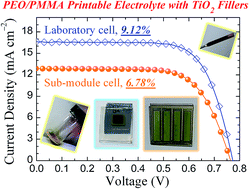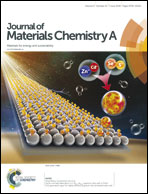Highly efficient quasi-solid-state dye-sensitized solar cells using polyethylene oxide (PEO) and poly(methyl methacrylate) (PMMA)-based printable electrolytes†
Abstract
In this study, highly efficient printable electrolytes (PEs) were prepared for a quasi-solid-state dye-sensitized solar cell (QS-DSSC). A liquid electrolyte based on iodide/triiodide redox couples and 3-methoxypropionitrile (MPN) was utilized to prepare the PEs. Poly(ethylene oxide) (PEO) and poly(methyl methacrylate) (PMMA) were employed as solidifying agents to optimize the properties of the PEs. Moreover, TiO2 nanofillers (NFs) were added to the PEs to enhance the performance of the DSSCs. The results indicate that a PE based on a PEO/PMMA ratio of 7/3 was optimal for efficient printing. The energy conversion efficiency of the DSSC achieved by using this PE was 8.48%, which was higher than the efficiencies of the cell using only PEO PE (7.63%) and liquid-cells (8.32%). This was mainly due to the increase in the electrolyte conductivity and charge transfer resistance at the photoelectrode/electrolyte interface of the DSSC. The presence of 10 wt% TiO2 NFs in the PEs increased the efficiency of the QS-DSSC to 9.12%. The sub-module cell fabricated by using the PE with TiO2 NFs achieved an efficiency of 6.78%. The PE based DSSC exhibited stable long-term efficiency during thermal aging at 60 °C.



 Please wait while we load your content...
Please wait while we load your content...